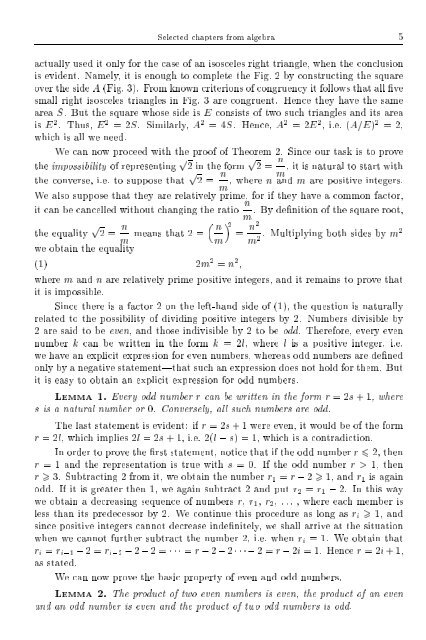SELECTED CHAPTERS FROM ALGEBRA I. R. Shafarevich Preface
SELECTED CHAPTERS FROM ALGEBRA I. R. Shafarevich Preface
SELECTED CHAPTERS FROM ALGEBRA I. R. Shafarevich Preface
You also want an ePaper? Increase the reach of your titles
YUMPU automatically turns print PDFs into web optimized ePapers that Google loves.
Selected chapters from algebra 5actually used it only for the case of an isosceles right triangle, when the conclusionis evident. Namely, it is enough to complete the Fig. 2 by constructing the squareover the side A (Fig. 3). From known criterions of congruency it follows that all vesmall right isosceles triangles in Fig. 3 are congruent. Hence they have the samearea S. But the square whose side is E consists of two such triangles and its areais E 2 . Thus, E 2 =2S. Similarly, A 2 =4S. Hence, A 2 =2E 2 , i.e. (A=E) 2 =2,which isallwe need.We cannow proceed with the proof of Theorem 2. Since our task is to provethe impossibility of representing p 2intheform p 2= n , it is natural to start withmthe converse, i.e. to suppose that p 2= n , where n and m are positive integers.mWe also suppose that they are relatively prime, for if they have a common factor,it can be cancelled without changing the ratio n . By denition of the square root,m2 n 2=the equality p 2= n nm means that 2 = mwe obtain the equality(1) 2m 2 = n 2 . Multiplying both sides by m2m2 where m and n are relatively prime positive integers, and it remains to prove thatit is impossible.Since there is a factor 2 on the left-hand side of (1), the question is naturallyrelated to the possibility of dividing positive integers by 2. Numbers divisible by2 are said to be even, and those indivisible by 2tobeodd. Therefore, every evennumber k can be written in the form k = 2l, where l is a positive integer, i.e.we have an explicit expression for even numbers, whereas odd numbers are denedonly by a negative statement|that such an expression does not hold for them. Butit is easy to obtain an explicit expression for odd numbers.LEMMA 1. Every odd number r can be written in the form r =2s +1,wheres is a natural number or 0. Conversely, all such numbers are odd.The last statement is evident: if r =2s +1were even, it would be of the formr =2l, which implies 2l =2s + 1, i.e. 2(l ; s) = 1, which is a contradiction.In order to prove the rst statement, notice that if the odd number r 6 2, thenr =1andtherepresentation is true with s =0. If the odd number r > 1, thenr > 3. Subtracting 2 from it, we obtain the number r 1 = r ; 2 > 1, and r 1 is againodd. If it is greater then 1, we again subtract 2 and put r 2 = r 1 ; 2. In this waywe obtain a decreasing sequence of numbers r, r 1 , r 2 , . . . , where each member isless than its predecessor by 2. We continue this procedure as long as r i > 1, andsince positive integers cannot decrease indenitely, we shall arrive at the situationwhen we cannot further subtract the number 2, i.e. when r i =1. We obtain thatr i = r i;1 ; 2=r i;2 ; 2 ; 2== r ; 2 ; 2 ;2=r ; 2i =1. Hence r =2i +1,as stated.We can now prove the basic property ofeven and odd numbers.LEMMA 2. The product of two even numbers is even, the product of an evenandanodd number is even and the product of two odd numbers is odd.
















